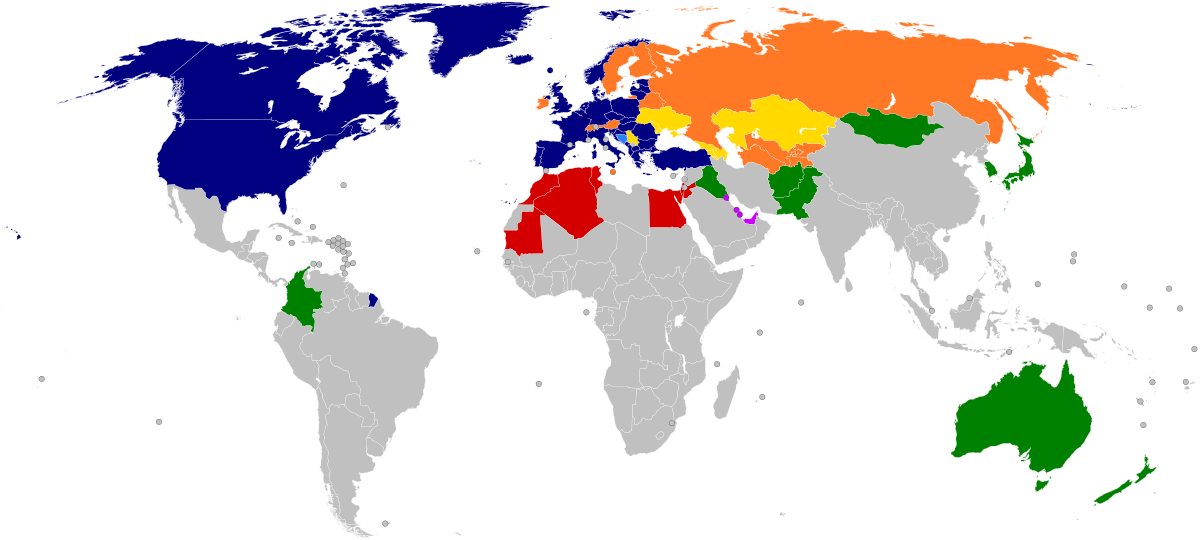NATO
The North Atlantic Treaty Organization (NATO, /ˈneɪtoʊ/; French: Organisation du traité de l'Atlantique nord, OTAN), also called the North Atlantic Alliance, is an intergovernmental military alliance between 30 North American and European countries. The organization implements the North Atlantic Treaty that was signed on 4 April 1949.[3][4] NATO constitutes a system of collective defence whereby its independent member states agree to mutual defence in response to an attack by any external party. NATO's Headquarters are located in Evere, Brussels, Belgium, while the headquarters of Allied Command Operations is near Mons, Belgium.
Organisation du traité de l'Atlantique nord | |
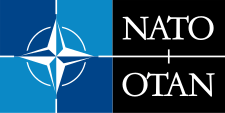 Logo | |
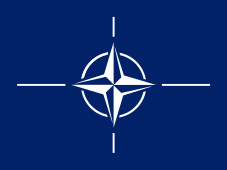 | |
.svg.png) Member states of NATO | |
| Abbreviation | NATO, OTAN |
|---|---|
| Motto | Animus in consulendo liber |
| Formation | 4 April 1949 |
| Type | Military alliance |
| Headquarters | Brussels, Belgium |
Membership | |
Official language | |
| Jens Stoltenberg | |
| Air Chief Marshal Stuart Peach, Royal Air Force | |
| General Tod D. Wolters, United States Air Force | |
| Général André Lanata, French Air Force | |
| Expenses (2018) | US$1.0 trillion[2] |
| Website | www |
"The NATO Hymn" | |
Since its founding, the admission of new member states has increased the alliance from the original 12 countries to 30. The most recent member state to be added to NATO was North Macedonia on 27 March 2020. NATO currently recognizes Bosnia and Herzegovina, Georgia, and Ukraine as aspiring members.[5] An additional 20 countries participate in NATO's Partnership for Peace program, with 15 other countries involved in institutionalized dialogue programs. The combined military spending of all NATO members constitutes over 70% of the global total.[6] Members agreed that their aim is to reach or maintain the target defense spending of at least 2% of GDP by 2024.[7][8]
History
On 4 March 1947, the Treaty of Dunkirk was signed by France and the United Kingdom as a Treaty of Alliance and Mutual Assistance in the event of a possible attack by Germany or the Soviet Union in the aftermath of World War II. In 1948, this alliance was expanded to include the Benelux countries, in the form of the Western Union, also referred to as the Brussels Treaty Organization (BTO), established by the Treaty of Brussels.[9] Talks for a new military alliance which could also include North America resulted in the signature of the North Atlantic Treaty on 4 April 1949 by the member states of the Western Union plus the United States, Canada, Portugal, Italy, Norway, Denmark and Iceland.[10]
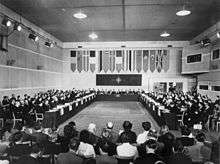
The North Atlantic Treaty was largely dormant until the Korean War initiated the establishment of NATO to implement it, by means of an integrated military structure: This included the formation of Supreme Headquarters Allied Powers Europe (SHAPE) in 1951, which adopted the Western Union's military structures and plans.[11] In 1952, the post of Secretary General of NATO was established as the organization's chief civilian. That year also saw the first major NATO maritime exercises, Exercise Mainbrace and the accession of Greece and Turkey to the organization.[12][13] Following the London and Paris Conferences, West Germany was permitted to rearm militarily, as they joined NATO in May 1955, which was, in turn, a major factor in the creation of the Soviet-dominated Warsaw Pact, delineating the two opposing sides of the Cold War.
Doubts over the strength of the relationship between the European states and the United States ebbed and flowed, along with doubts over the credibility of the NATO defense against a prospective Soviet invasion – doubts that led to the development of the independent French nuclear deterrent and the withdrawal of France from NATO's military structure in 1966.[14][15] In 1982, the newly democratic Spain joined the alliance.
The collapse of the Warsaw Pact in 1989–1991 removed the de facto main adversary of NATO and caused a strategic re-evaluation of NATO's purpose, nature, tasks, and focus on the continent of Europe. This shift started with the 1990 signing in Paris of the Treaty on Conventional Armed Forces in Europe between NATO and the Soviet Union, which mandated specific military reductions across the continent that continued after the dissolution of the Soviet Union in December 1991.[16] At that time, European countries accounted for 34 percent of NATO's military spending; by 2012, this had fallen to 21 percent.[17] NATO also began a gradual expansion to include newly autonomous Central and Eastern European nations, and extended its activities into political and humanitarian situations that had not formerly been NATO concerns.[18]

After the fall of the Berlin Wall in Germany in 1989, the organization conducted its first military interventions in Bosnia from 1992 to 1995 and later Yugoslavia in 1999 during the break-up of Yugoslavia.[19] Politically, the organization sought better relations with former Warsaw Pact countries, most of which joined the alliance in 1999 and 2004. Article 5 of the North Atlantic treaty, requiring member states to come to the aid of any member state subject to an armed attack, was invoked for the first and only time after the September 11 attacks,[20] after which troops were deployed to Afghanistan under the NATO-led ISAF. The organization has operated a range of additional roles since then, including sending trainers to Iraq, assisting in counter-piracy operations[21] and in 2011 enforcing a no-fly zone over Libya in accordance with UN Security Council Resolution 1973. The less potent Article 4, which merely invokes consultation among NATO members, has been invoked five times following incidents in the Iraq War, Syrian Civil War, and annexation of Crimea.[22]
The first post-Cold War expansion of NATO came with German reunification on 3 October 1990, when the former East Germany became part of the Federal Republic of Germany and the alliance. As part of post-Cold War restructuring, NATO's military structure was cut back and reorganized, with new forces such as the Headquarters Allied Command Europe Rapid Reaction Corps established. The changes brought about by the collapse of the Soviet Union on the military balance in Europe were recognized in the Adapted Conventional Armed Forces in Europe Treaty, which was signed in 1999. The policies of French President Nicolas Sarkozy resulted in a major reform of France's military position, culminating with the return to full membership on 4 April 2009, which also included France rejoining the NATO Military Command Structure, while maintaining an independent nuclear deterrent.[15][23][24]
Between 1994 and 1997, wider forums for regional cooperation between NATO and its neighbors were set up, like the Partnership for Peace, the Mediterranean Dialogue initiative and the Euro-Atlantic Partnership Council. In 1998, the NATO–Russia Permanent Joint Council was established. Between 1999 and 2020 NATO incorporated the following Central and Eastern European countries, including several former communist states: the Czech Republic, Hungary, Poland, Bulgaria, Estonia, Latvia, Lithuania, Romania, Slovakia, Slovenia, Albania, Croatia, Montenegro, and North Macedonia.[18]
The Russian intervention in Crimea in 2014 led to strong condemnation by NATO nations and the creation of a new "spearhead" force of 5,000 troops at bases in Estonia, Lithuania, Latvia, Poland, Romania, and Bulgaria.[25] At the subsequent 2014 Wales summit, the leaders of NATO's member states formally committed for the first time to spend the equivalent of at least 2% of their gross domestic products on defence by 2024, which had previously been only an informal guideline.[26] NATO did not condemn the 2016–present purges in Turkey.[27] NATO members have resisted the UN's Nuclear Weapon Ban Treaty, a binding agreement for negotiations for the total elimination of nuclear weapons, supported by more than 120 nations.[28]
Military operations
Early operations
No military operations were conducted by NATO during the Cold War. Following the end of the Cold War, the first operations, Anchor Guard in 1990 and Ace Guard in 1991, were prompted by the Iraqi invasion of Kuwait. Airborne early warning aircraft were sent to provide coverage of southeastern Turkey, and later a quick-reaction force was deployed to the area.[29]
Bosnia and Herzegovina intervention
The Bosnian War began in 1992, as a result of the break-up of Yugoslavia. The deteriorating situation led to United Nations Security Council Resolution 816 on 9 October 1992, ordering a no-fly zone over central Bosnia and Herzegovina, which NATO began enforcing on 12 April 1993 with Operation Deny Flight. From June 1993 until October 1996, Operation Sharp Guard added maritime enforcement of the arms embargo and economic sanctions against the Federal Republic of Yugoslavia. On 28 February 1994, NATO took its first wartime action by shooting down four Bosnian Serb aircraft violating the no-fly zone.[30]
On 10 and 11 April 1994, the United Nations Protection Force called in air strikes to protect the Goražde safe area, resulting in the bombing of a Bosnian Serb military command outpost near Goražde by two US F-16 jets acting under NATO direction.[31] In retaliation, Serbs took 150 U.N. personnel hostage on 14 April.[32][33] On 16 April a British Sea Harrier was shot down over Goražde by Serb forces.[34]
In August 1995, a two-week NATO bombing campaign, Operation Deliberate Force, began against the Army of the Republika Srpska, after the Srebrenica massacre.[35] Further NATO air strikes helped bring the Yugoslav wars to an end, resulting in the Dayton Agreement in November 1995.[35] As part of this agreement, NATO deployed a UN-mandated peacekeeping force, under Operation Joint Endeavor, named IFOR. Almost 60,000 NATO troops were joined by forces from non-NATO nations in this peacekeeping mission. This transitioned into the smaller SFOR, which started with 32,000 troops initially and ran from December 1996 until December 2004, when operations were then passed onto European Union Force Althea.[36] Following the lead of its member nations, NATO began to award a service medal, the NATO Medal, for these operations.[37]
Kosovo intervention
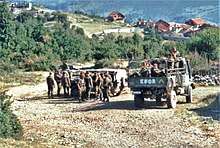
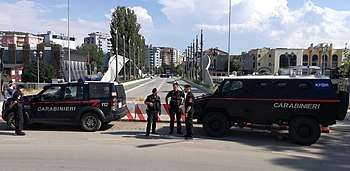
In an effort to stop Slobodan Milošević's Serbian-led crackdown on KLA separatists and Albanian civilians in Kosovo, the United Nations Security Council passed Resolution 1199 on 23 September 1998 to demand a ceasefire. Negotiations under US Special Envoy Richard Holbrooke broke down on 23 March 1999, and he handed the matter to NATO,[38] which started a 78-day bombing campaign on 24 March 1999.[39] Operation Allied Force targeted the military capabilities of what was then the Federal Republic of Yugoslavia. During the crisis, NATO also deployed one of its international reaction forces, the ACE Mobile Force (Land), to Albania as the Albania Force (AFOR), to deliver humanitarian aid to refugees from Kosovo.[40]
Though the campaign was criticized for high civilian casualties, including bombing of the Chinese embassy in Belgrade, Milošević finally accepted the terms of an international peace plan on 3 June 1999, ending the Kosovo War. On 11 June, Milošević further accepted UN resolution 1244, under the mandate of which NATO then helped establish the KFOR peacekeeping force. Nearly one million refugees had fled Kosovo, and part of KFOR's mandate was to protect the humanitarian missions, in addition to deterring violence.[40][41] In August–September 2001, the alliance also mounted Operation Essential Harvest, a mission disarming ethnic Albanian militias in the Republic of Macedonia.[42] As of 1 December 2013, 4,882 KFOR soldiers, representing 31 countries, continue to operate in the area.[43]
The US, the UK, and most other NATO countries opposed efforts to require the UN Security Council to approve NATO military strikes, such as the action against Serbia in 1999, while France and some others claimed that the alliance needed UN approval.[44] The US/UK side claimed that this would undermine the authority of the alliance, and they noted that Russia and China would have exercised their Security Council vetoes to block the strike on Yugoslavia, and could do the same in future conflicts where NATO intervention was required, thus nullifying the entire potency and purpose of the organization. Recognizing the post-Cold War military environment, NATO adopted the Alliance Strategic Concept during its Washington summit in April 1999 that emphasized conflict prevention and crisis management.[45]
War in Afghanistan
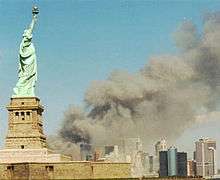
The September 11 attacks in the United States caused NATO to invoke Article 5 of the NATO Charter for the first time in the organization's history. The Article states that an attack on any member shall be considered to be an attack on all. The invocation was confirmed on 4 October 2001 when NATO determined that the attacks were indeed eligible under the terms of the North Atlantic Treaty.[46] The eight official actions taken by NATO in response to the attacks included Operation Eagle Assist and Operation Active Endeavour, a naval operation in the Mediterranean Sea designed to prevent the movement of terrorists or weapons of mass destruction, and to enhance the security of shipping in general, which began on 4 October 2001.[47]
The alliance showed unity: On 16 April 2003, NATO agreed to take command of the International Security Assistance Force (ISAF), which included troops from 42 countries. The decision came at the request of Germany and the Netherlands, the two nations leading ISAF at the time of the agreement, and all nineteen NATO ambassadors approved it unanimously. The handover of control to NATO took place on 11 August, and marked the first time in NATO's history that it took charge of a mission outside the north Atlantic area.[48]
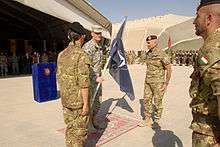
ISAF was initially charged with securing Kabul and surrounding areas from the Taliban, al Qaeda and factional warlords, so as to allow for the establishment of the Afghan Transitional Administration headed by Hamid Karzai. In October 2003, the UN Security Council authorized the expansion of the ISAF mission throughout Afghanistan,[49] and ISAF subsequently expanded the mission in four main stages over the whole of the country.[50]
On 31 July 2006, the ISAF additionally took over military operations in the south of Afghanistan from a US-led anti-terrorism coalition.[51] Due to the intensity of the fighting in the south, in 2011 France allowed a squadron of Mirage 2000 fighter/attack aircraft to be moved into the area, to Kandahar, in order to reinforce the alliance's efforts.[52] During its 2012 Chicago Summit, NATO endorsed a plan to end the Afghanistan war and to remove the NATO-led ISAF Forces by the end of December 2014.[53] ISAF was disestablished in December 2014 and replaced by the follow-on training Resolute Support Mission.[54]
Iraq training mission
In August 2004, during the Iraq War, NATO formed the NATO Training Mission – Iraq, a training mission to assist the Iraqi security forces in conjunction with the US led MNF-I.[55] The NATO Training Mission-Iraq (NTM-I) was established at the request of the Iraqi Interim Government under the provisions of United Nations Security Council Resolution 1546. The aim of NTM-I was to assist in the development of Iraqi security forces training structures and institutions so that Iraq can build an effective and sustainable capability that addresses the needs of the nation. NTM-I was not a combat mission but is a distinct mission, under the political control of NATO's North Atlantic Council. Its operational emphasis was on training and mentoring. The activities of the mission were coordinated with Iraqi authorities and the US-led Deputy Commanding General Advising and Training, who was also dual-hatted as the Commander of NTM-I. The mission officially concluded on 17 December 2011.[56]
Turkey invoked the first Article 4 meetings in 2003 at the start of the Iraq War. Turkey also invoked this article twice in 2012 during the Syrian Civil War, after the downing of an unarmed Turkish F-4 reconnaissance jet, and after a mortar was fired at Turkey from Syria,[57] and again in 2015 after threats by Islamic State of Iraq and the Levant to its territorial integrity.[58]
Gulf of Aden anti-piracy
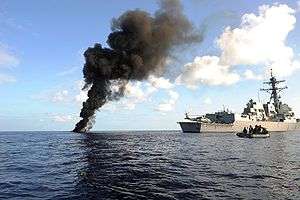
Beginning on 17 August 2009, NATO deployed warships in an operation to protect maritime traffic in the Gulf of Aden and the Indian Ocean from Somali pirates, and help strengthen the navies and coast guards of regional states. The operation was approved by the North Atlantic Council and involves warships primarily from the United States though vessels from many other nations are also included. Operation Ocean Shield focuses on protecting the ships of Operation Allied Provider which are distributing aid as part of the World Food Programme mission in Somalia. Russia, China and South Korea have sent warships to participate in the activities as well.[59][60] The operation seeks to dissuade and interrupt pirate attacks, protect vessels, and abetting to increase the general level of security in the region.[61]
Libya intervention
During the Libyan Civil War, violence between protesters and the Libyan government under Colonel Muammar Gaddafi escalated, and on 17 March 2011 led to the passage of United Nations Security Council Resolution 1973, which called for a ceasefire, and authorized military action to protect civilians. A coalition that included several NATO members began enforcing a no-fly zone over Libya shortly afterwards, beginning with Opération Harmattan by the French Air Force on 19 March.
On 20 March 2011, NATO states agreed on enforcing an arms embargo against Libya with Operation Unified Protector using ships from NATO Standing Maritime Group 1 and Standing Mine Countermeasures Group 1,[62] and additional ships and submarines from NATO members.[63] They would "monitor, report and, if needed, interdict vessels suspected of carrying illegal arms or mercenaries".[62]

On 24 March, NATO agreed to take control of the no-fly zone from the initial coalition, while command of targeting ground units remained with the coalition's forces.[64][65] NATO began officially enforcing the UN resolution on 27 March 2011 with assistance from Qatar and the United Arab Emirates.[66] By June, reports of divisions within the alliance surfaced as only eight of the 28 member nations were participating in combat operations,[67] resulting in a confrontation between US Defense Secretary Robert Gates and countries such as Poland, Spain, the Netherlands, Turkey, and Germany to contribute more, the latter believing the organization has overstepped its mandate in the conflict.[68][69][70] In his final policy speech in Brussels on 10 June, Gates further criticized allied countries in suggesting their actions could cause the demise of NATO.[71] The German foreign ministry pointed to "a considerable [German] contribution to NATO and NATO-led operations" and to the fact that this engagement was highly valued by President Obama.[72]
While the mission was extended into September, Norway that day announced it would begin scaling down contributions and complete withdrawal by 1 August.[73] Earlier that week it was reported Danish air fighters were running out of bombs.[74][75] The following week, the head of the Royal Navy said the country's operations in the conflict were not sustainable.[76] By the end of the mission in October 2011, after the death of Colonel Gaddafi, NATO planes had flown about 9,500 strike sorties against pro-Gaddafi targets.[77][78] A report from the organization Human Rights Watch in May 2012 identified at least 72 civilians killed in the campaign.[79] Following a coup d'état attempt in October 2013, Libyan Prime Minister Ali Zeidan requested technical advice and trainers from NATO to assist with ongoing security issues.[80]
Membership
.jpg)
NATO has thirty members, mainly in Europe and North America. Some of these countries also have territory on multiple continents, which can be covered only as far south as the Tropic of Cancer in the Atlantic Ocean, which defines NATO's "area of responsibility" under Article 6 of the North Atlantic Treaty. During the original treaty negotiations, the United States insisted that colonies such as the Belgian Congo be excluded from the treaty.[81][82] French Algeria was however covered until their independence on 3 July 1962.[83] Twelve of these thirty are original members who joined in 1949, while the other eighteen joined in one of eight enlargement rounds.
From the mid-1960s to the mid-1990s, France pursued a military strategy of independence from NATO under a policy dubbed "Gaullo-Mitterrandism".[84] Nicolas Sarkozy negotiated the return of France to the integrated military command and the Defence Planning Committee in 2009, the latter being disbanded the following year. France remains the only NATO member outside the Nuclear Planning Group and unlike the United States and the United Kingdom, will not commit its nuclear-armed submarines to the alliance.[15][23] Few members spend more than two percent of their gross domestic product on defence,[85] with the United States accounting for three quarters of NATO defence spending.[86]
Enlargement
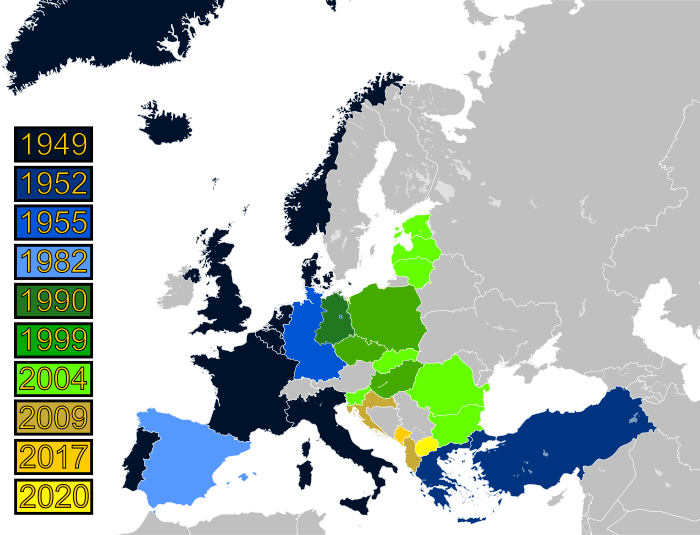
New membership in the alliance has been largely from Central and Eastern Europe, including former members of the Warsaw Pact. Accession to the alliance is governed with individual Membership Action Plans, and requires approval by each current member. NATO currently has one candidate country that is in the process of joining the alliance: Bosnia and Herzegovina. North Macedonia signed an accession protocol to become a NATO member state in February 2019, and became a member state on 27 March 2020.[87][88] Its accession had been blocked by Greece for many years due to the Macedonia naming dispute, which was resolved in 2018 by the Prespa agreement.[89] In order to support each other in the process, new and potential members in the region formed the Adriatic Charter in 2003.[90] Georgia was also named as an aspiring member, and was promised "future membership" during the 2008 summit in Bucharest,[91] though in 2014, US President Barack Obama said the country was not "currently on a path" to membership.[92]
Russia continues to politically oppose further expansion, seeing it as inconsistent with informal understandings between Soviet leader Mikhail Gorbachev and European and US negotiators that allowed for a peaceful German reunification.[93] NATO's expansion efforts are often seen by Moscow leaders as a continuation of a Cold War attempt to surround and isolate Russia,[94] though they have also been criticized in the West.[95] A June 2016 Levada poll found that 68% of Russians think that deploying NATO troops in the Baltic states and Poland—former Eastern bloc countries bordering Russia—is a threat to Russia.[96] In contrast 65% of Poles surveyed in a 2017 Pew Research Center report identified Russia as a "major threat", with an average of 31% saying so across all NATO countries,[97] and 67% of Poles surveyed in 2018 favour US forces being based in Poland.[98] Of non-CIS Eastern European countries surveyed by Gallup in 2016, all but Serbia and Montenegro were more likely than not to view NATO as a protective alliance rather than a threat.[99] A 2006 study in the journal Security Studies argued that NATO enlargement contributed to democratic consolidation in Central and Eastern Europe.[100]
Ukraine's relationship with NATO and Europe has been politically controversial, and improvement of these relations was one of the goals of the "Euromaidan" protests that saw the ousting of pro-Russian President Viktor Yanukovych in 2014. In March 2014, Prime Minister Arseniy Yatsenyuk reiterated the government's stance that Ukraine is not seeking NATO membership.[101] Ukraine's president subsequently signed a bill dropping his nation's nonaligned status in order to pursue NATO membership, but signalled that it would hold a referendum before seeking to join.[102] Ukraine is one of eight countries in Eastern Europe with an Individual Partnership Action Plan. IPAPs began in 2002, and are open to countries that have the political will and ability to deepen their relationship with NATO.[103]
Partnerships with third countries
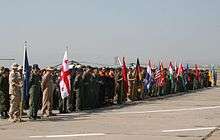
The Partnership for Peace (PfP) programme was established in 1994 and is based on individual bilateral relations between each partner country and NATO: each country may choose the extent of its participation.[105] Members include all current and former members of the Commonwealth of Independent States.[106] The Euro-Atlantic Partnership Council (EAPC) was first established on 29 May 1997, and is a forum for regular coordination, consultation and dialogue between all fifty participants.[107] The PfP programme is considered the operational wing of the Euro-Atlantic Partnership.[105] Other third countries also have been contacted for participation in some activities of the PfP framework such as Afghanistan.[108]
The European Union (EU) signed a comprehensive package of arrangements with NATO under the Berlin Plus agreement on 16 December 2002. With this agreement, the EU was given the possibility of using NATO assets in case it wanted to act independently in an international crisis, on the condition that NATO itself did not want to act – the so-called "right of first refusal".[109] For example, Article 42(7) of the 1982 Treaty of Lisbon specifies that "If a Member State is the victim of armed aggression on its territory, the other Member States shall have towards it an obligation of aid and assistance by all the means in their power". The treaty applies globally to specified territories whereas NATO is restricted under its Article 6 to operations north of the Tropic of Cancer. It provides a "double framework" for the EU countries that are also linked with the PfP programme.
Additionally, NATO cooperates and discusses its activities with numerous other non-NATO members. The Mediterranean Dialogue was established in 1994 to coordinate in a similar way with Israel and countries in North Africa. The Istanbul Cooperation Initiative was announced in 2004 as a dialogue forum for the Middle East along the same lines as the Mediterranean Dialogue. The four participants are also linked through the Gulf Cooperation Council.[110] In June 2018, Qatar expressed its wish to join NATO.[111] However, NATO declined membership, stating that only additional European countries could join according to Article 10 of NATO's founding treaty.[112] Qatar and NATO have previously signed a security agreement together in January 2018.[113]
Political dialogue with Japan began in 1990, and since then, the Alliance has gradually increased its contact with countries that do not form part of any of these cooperation initiatives.[114] In 1998, NATO established a set of general guidelines that do not allow for a formal institutionalization of relations, but reflect the Allies' desire to increase cooperation. Following extensive debate, the term "Contact Countries" was agreed by the Allies in 2000. By 2012, the Alliance had broadened this group, which meets to discuss issues such as counter-piracy and technology exchange, under the names "partners across the globe" or "global partners".[115][116] Australia and New Zealand, both contact countries, are also members of the AUSCANNZUKUS strategic alliance, and similar regional or bilateral agreements between contact countries and NATO members also aid cooperation. NATO Secretary General Jens Stoltenberg stated that NATO needs to "address the rise of China," by closely cooperating with Australia, New Zealand, Japan and South Korea.[117] Colombia is the NATO's latest partner and Colombia has access to the full range of cooperative activities NATO offers to partners; Colombia became the first and only Latin American country to cooperate with NATO.[118]
Structure
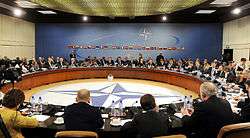
All agencies and organizations of NATO are integrated into either the civilian administrative or military executive roles. For the most part they perform roles and functions that directly or indirectly support the security role of the alliance as a whole.
The civilian structure includes:
- The North Atlantic Council (NAC) is the body which has effective governance authority and powers of decision in NATO, consisting of member states' permanent representatives or representatives at higher level (ministers of foreign affairs or defence, or heads of state or government). The NAC convenes at least once a week and takes major decisions regarding NATO's policies. The meetings of the North Atlantic Council are chaired by the Secretary General and, when decisions have to be made, action is agreed upon on the basis of unanimity and common accord. There is no voting or decision by majority. Each nation represented at the Council table or on any of its subordinate committees retains complete sovereignty and responsibility for its own decisions.
- NATO Headquarters, located on Boulevard Léopold III/Leopold III-laan, B-1110 Brussels, which is in Haren, part of the City of Brussels municipality.[119] The staff at the Headquarters is composed of national delegations of member countries and includes civilian and military liaison offices and officers or diplomatic missions and diplomats of partner countries, as well as the International Staff and International Military Staff filled from serving members of the armed forces of member states.[120] Non-governmental citizens' groups have also grown up in support of NATO, broadly under the banner of the Atlantic Council/Atlantic Treaty Association movement.
The military structure includes:
- The Military Committee (MC) is the body of NATO that is composed of member states' Chiefs of Defence (CHOD) and advises the North Atlantic Council (NAC) on military policy and strategy. The national CHODs are regularly represented in the MC by their permanent Military Representatives (MilRep), who often are two- or three-star flag officers. Like the council, from time to time the Military Committee also meets at a higher level, namely at the level of Chiefs of Defence, the most senior military officer in each nation's armed forces. The MC is led by its chairman, who directs NATO's military operations. Until 2008 the Military Committee excluded France, due to that country's 1966 decision to remove itself from the NATO Military Command Structure, which it rejoined in 1995. Until France rejoined NATO, it was not represented on the Defence Planning Committee, and this led to conflicts between it and NATO members.[121] Such was the case in the lead up to Operation Iraqi Freedom.[122] The operational work of the committee is supported by the International Military Staff
- Allied Command Operations (ACO) is the NATO command of responsible for NATO operations worldwide.
- The Rapid Deployable Corps include Eurocorps, I. German/Dutch Corps, Multinational Corps Northeast, and NATO Rapid Deployable Italian Corps among others, as well as naval High Readiness Forces (HRFs), which all report to Allied Command Operations.[123]
- Allied Command Transformation (ACT), responsible for transformation and training of NATO forces.
The organizations and agencies of NATO include:
- Headquarters for the NATO Support Agency will be in Capellen Luxembourg (site of the current NATO Maintenance and Supply Agency – NAMSA).
- The NATO Communications and Information Agency Headquarters will be in Brussels, as will the very small staff which will design the new NATO Procurement Agency.
- A new NATO Science and Technology (S&T) Organization will be created before July 2012, consisting of Chief Scientist, a Programme Office for Collaborative S&T, and the NATO Undersea Research Centre (NURC).
- The current NATO Standardization Agency will continue and be subject to review by Spring 2014.
The NATO Parliamentary Assembly (NATO PA) is a body that sets broad strategic goals for NATO, which meets at two session per year. NATO PA interacts directly with the parliamentary structures of the national governments of the member states which appoint Permanent Members, or ambassadors to NATO. The NATO Parliamentary Assembly is made up of legislators from the member countries of the North Atlantic Alliance as well as thirteen associate members. It is however officially a different structure from NATO, and has as aim to join together deputies of NATO countries in order to discuss security policies on the NATO Council.
See also
- Common Security and Defence Policy of the European Union
- Ranks and insignia of NATO
Similar organizations
- ANZUS (Australia, New Zealand, United States Security Treaty)
- Central Treaty Organization (CENTO)
- Collective Security Treaty Organization (CSTO)
- Five Power Defence Arrangements (FPDA)
- Inter-American Treaty of Reciprocal Assistance
- Islamic Military Counter Terrorism Coalition (IMCTC)
- Shanghai Cooperation Organization (SCO)
- South Atlantic Peace and Cooperation Zone
- Southeast Asia Treaty Organization (SEATO)
References
- "English and French shall be the official languages for the entire North Atlantic Treaty Organization." Final Communiqué following the meeting of the North Atlantic Council on 17 September 1949 Archived 6 December 2006 at the Wayback Machine. "... the English and French texts [of the Treaty] are equally authentic ..." The North Atlantic Treaty, Article 14 Archived 14 September 2011 at the Wayback Machine
- "Defence Expenditure of NATO Countries (2010–2018)" (PDF). Nato.int. Archived (PDF) from the original on 30 October 2018. Retrieved 10 July 2018.
- "What is NATO?". NATO Headquarters, Brussels, Belgium. 26 May 2017. Archived from the original on 5 November 2014. Retrieved 26 May 2017.
- Cook, Lorne (25 May 2017). "NATO: The World's Largest Military Alliance Explained". MilitaryTimes.com. The Associated Press. Archived from the original on 25 May 2017. Retrieved 26 May 2017.
- NATO. "Enlargement". NATO. Archived from the original on 11 March 2018. Retrieved 18 March 2018.
- "The SIPRI Military Expenditure Database". Milexdata.sipri.org. Archived from the original on 28 March 2010. Retrieved 22 August 2010.
- The Wales Declaration on the Transatlantic Bond Archived 10 June 2018 at the Wayback Machine, NATO, 5 September 2014.
- Erlanger, Steven (26 March 2014). "Europe Begins to Rethink Cuts to Military Spending". nytimes.com. Archived from the original on 29 March 2014. Retrieved 3 April 2014.
Last year, only a handful of NATO countries met the target, according to NATO figures, including the United States, at 4.1 percent, and Britain, at 2.4 percent.
- "The origins of WEU: Western Union". University of Luxembourg. December 2009. Archived from the original on 21 June 2018. Retrieved 23 July 2018.
- "A short history of NATO". NATO. Archived from the original on 26 March 2017. Retrieved 26 March 2017.
- Ismay, Hastings (4 September 2001). "NATO the first five years 1949–1954". NATO. Archived from the original on 15 March 2017. Retrieved 10 April 2012.
- Baldwin, Hanson (28 September 1952). "Navies Meet the Test in Operation Mainbrace". New York Times: E7. Archived from the original on 10 October 2017. Retrieved 10 April 2012.
- "NATO: The Man with the Oilcan". Time. 24 March 1952. Archived from the original on 8 January 2012. Retrieved 17 January 2012.
- van der Eyden 2003, pp. 104–106.
- Cody, Edward (12 March 2009). "After 43 Years, France to Rejoin NATO as Full Member". The Washington Post. Archived from the original on 26 October 2017. Retrieved 19 December 2011.
- Harding, Luke (14 July 2007). "Kremlin tears up arms pact with Nato". The Observer. Archived from the original on 31 August 2013. Retrieved 1 May 2012.
- "The future of NATO: Bad timing". The Economist. 31 March 2012. Archived from the original on 2 April 2012. Retrieved 3 April 2012.
- "NATO Announces Special 70th Anniversary Summit In London In December". Radio Free Europe/Radio Liberty. 6 February 2019. Archived from the original on 6 April 2019. Retrieved 6 April 2019.
- Jing Ke (2008). "Did the US Media Reflect the Reality of the Kosovo War in an Objective Manner? A Case Study of The Washington Post and The Washington Times" (PDF). University of Rhode Island. Archived (PDF) from the original on 23 March 2019.
In 1999, NATO unprecedently involved itself in the Kosovo War by bombing the FRY (Federal Republic of Yugoslavia) without the UN approval.
- "Invocation of Article 5 confirmed". North Atlantic Treaty Organization. 3 October 2001. Archived from the original on 30 December 2012. Retrieved 29 January 2013.
- "Counter-piracy operations". North Atlantic Treaty Organization. Archived from the original on 26 May 2011. Retrieved 27 May 2011.
- "The consultation process and Article 4". NATO. 17 March 2016. Archived from the original on 6 April 2019. Retrieved 6 April 2019.
- Stratton, Allegra (17 June 2008). "Sarkozy military plan unveiled". The Guardian. UK. Archived from the original on 7 March 2016. Retrieved 17 December 2016.
- "Defence Planning Committee (DPC) (Archived)". NATO. 11 November 2014. Archived from the original on 22 December 2015. Retrieved 13 August 2016.
- "Statement by the North Atlantic Council following meeting under article 4 of the Washington Treaty". NATO Newsroom. 4 March 2014. Archived from the original on 10 March 2014. Retrieved 2 April 2014.
- Techau, Jan (2 September 2015). "The Politics of 2 Percent: NATO and the Security Vacuum in Europe". Carnegie Europe. Archived from the original on 12 July 2018. Retrieved 11 July 2018.
A month before [the alliance's summit in Riga in 2006], Victoria Nuland, then the U.S. ambassador to NATO, called the 2 percent metric the "unofficial floor" on defense spending in NATO. But never had all governments of NATO's 28 nations officially embraced it at the highest possible political level – a summit declaration.
- "NATO declines to condemn arrests of Turkish legislators, journalists". Deutsche Presse-Agentur. 21 November 2016.
- "122 countries adopt 'historic' UN treaty to ban nuclear weapons". CBC News. 7 July 2017.
- "NATO's Operations 1949–Present" (PDF). NATO. 2009. Archived (PDF) from the original on 1 March 2013. Retrieved 3 March 2013.
- Zenko 2010, pp. 133–134.
- Zenko 2010, p. 134.
- NATO Handbook: Evolution of the Conflict, NATO, archived from the original on 7 November 2001
- UN Document A/54/549, Report of the Secretary-General pursuant to General Assembly resolution 53/35: The fall of Srebrenica, un.org, Archived 12 September 2009 at the Wayback Machine, accessed 25 April 2015.
- Bethlehem & Weller 1997, p. liiv.
- Zenko 2010, pp. 137–138
- Clausson 2006, pp. 94–97.
- Tice, Jim (22 February 2009). "Thousands more now eligible for NATO Medal". Army Times. Retrieved 11 April 2012.
- "Nato to strike Yugoslavia". BBC News. 24 March 1999. Archived from the original on 26 September 2015. Retrieved 25 September 2015.
- Thorpe, Nick (24 March 2004). "UN Kosovo mission walks a tightrope". BBC News. Archived from the original on 26 July 2012. Retrieved 11 April 2012.
- "Operation Shining Hope". Global Security. 5 July 2011. Archived from the original on 8 November 2012. Retrieved 11 April 2012.
- "Kosovo Report Card". International Crisis Group. 28 August 2000. Archived from the original on 4 March 2012. Retrieved 11 April 2012.
- Helm, Toby (27 September 2001). "Macedonia mission a success, says Nato". The Daily Telegraph. Archived from the original on 5 September 2012. Retrieved 11 April 2012.
- "Kosovo Force (KFOR) Key Facts and Figures" (PDF). NATO. 1 December 2013. Archived (PDF) from the original on 25 October 2014. Retrieved 4 September 2014.
- "NATO reaffirms power to take action without UN approval". CNN. 24 April 1999. Archived from the original on 28 January 2015. Retrieved 4 September 2013.
- "Allied Command Atlantic". NATO Handbook. NATO. Archived from the original on 13 August 2008. Retrieved 3 September 2008.
- "NATO Update: Invocation of Article 5 confirmed". Nato.int. 2 October 2001. Archived from the original on 25 August 2010. Retrieved 22 August 2010.
- "NATO's Operations 1949–Present" (PDF). NATO. 22 January 2010. Archived (PDF) from the original on 17 May 2013. Retrieved 4 September 2013.
- David P. Auerswald, and Stephen M. Saideman, eds. NATO in Afghanistan: Fighting Together, Fighting Alone (Princeton U.P., 2014)
- "UNSC Resolution 1510, October 13, 2003" (PDF). Archived (PDF) from the original on 9 October 2010. Retrieved 5 July 2010.
- "ISAF Chronology". Nato.int. Archived from the original on 13 November 2010. Retrieved 5 July 2010.
- Morales, Alex (5 October 2006). "NATO Takes Control of East Afghanistan From U.S.-Led Coalition". Bloomberg L.P. Archived from the original on 24 July 2014. Retrieved 4 September 2013.
- "La France et l'OTAN". Le Monde (in French). France. Archived from the original on 12 October 2007. Retrieved 16 July 2011.
- "NATO sets "irreversible" but risky course to end Afghan war". Reuters. Reuters. 21 May 2012. Archived from the original on 22 October 2012. Retrieved 22 May 2012.
- Rasmussen, Sune Engel (28 December 2014). "Nato ends combat operations in Afghanistan". The Guardian. ISSN 0261-3077. Retrieved 24 October 2019.
- "Official Website". Jfcnaples.nato.int. Archived from the original on 12 December 2011. Retrieved 29 January 2013.
- El Gamal, Rania (17 December 2011). "NATO closes up training mission in Iraq". Reuters. Archived from the original on 18 December 2011. Retrieved 17 January 2012.
- Croft, Adrian (3 October 2012). "NATO demands halt to Syria aggression against Turkey". Reuters. Archived from the original on 4 October 2012. Retrieved 3 October 2012.
- Ford, Dana (26 July 2015). "Turkey calls for rare NATO talks after attacks along Syrian border". Cnn.com. CNN. Archived from the original on 27 July 2015. Retrieved 26 July 2015.
- "Operation Ocean Shield". NATO. Archived from the original on 13 May 2011. Retrieved 3 March 2011.
- "2009 Operation Ocean Shield News Articles". NATO. October 2010. Archived from the original on 29 April 2011. Retrieved 19 May 2011.
- "Operation Ocean Shield purpose". 12 July 2016. Archived from the original on 13 September 2016. Retrieved 27 September 2016.
- "Statement by the NATO Secretary General on Libya arms embargo". NATO. 22 March 2011. Archived from the original on 28 April 2011. Retrieved 25 March 2011.
- "Press briefing by NATO Spokesperson Oana Lungescu, Brigadier General Pierre St-Amand, Canadian Air Force and General Massimo Panizzi, spokesperson of the Chairman of the Military Committee". NATO. 23 March 2011. Archived from the original on 28 April 2011. Retrieved 25 March 2011.
- "NATO reaches deal to take over Libya operation; allied planes hit ground forces". Washington Post. 25 March 2011. Archived from the original on 17 February 2013.
- "NATO to police Libya no-fly zone". English.aljazeera.net. 24 March 2011. Archived from the original on 26 March 2011. Retrieved 25 March 2011.
- O'Sullivan, Arieh (31 March 2011). "UAE and Qatar pack an Arab punch in Libya operation". Jerusalem Post. se. Archived from the original on 6 November 2012. Retrieved 29 January 2013.
- "NATO strikes Tripoli, Gaddafi army close on Misrata" Archived 12 August 2011 at the Wayback Machine, Khaled al-Ramahi. Malaysia Star. 9 June 2011. Retrieved 9 June 2011
- Coughlin, Con (9 June 2011). "Political Gridlock at NATO" Archived 10 October 2017 at the Wayback Machine, Wall Street Journal. Retrieved 9 June 2011
- "Gates Calls on NATO Allies to Do More in Libya", Jim Garamone. US Department of Defense. 8 June 2011. Retrieved 9 June 2011
- Cloud, David S. (9 June 2011). "Gates calls for more NATO allies to join Libya air campaign", Los Angeles Times. Retrieved 9 June 2011
- Burns, Robert (10 June 2011). "Gates blasts NATO, questions future of alliance" Archived 5 November 2013 at the Wayback Machine, Washington Times. Retrieved 29 January 2013
- Birnbaum, Michael (10 June 2011). "Gates rebukes European allies in farewell speech" Archived 25 August 2017 at the Wayback Machine, Washington Post. Retrieved 10 June 2011.
- Amland, Bjoern H. (10 June 2011). "Norway to quit Libya operation by August", Associated Press.
- "Danish planes running out of bombs" Archived 12 June 2011 at the Wayback Machine, Times of Malta. 10 June 2011. Retrieved 11 June 2011
- "Danish Planes in Libya Running Out of Bombs: Report", Defense News. 9 June 2011. Retrieved 11 June 2011
- "Navy chief: Britain cannot keep up its role in Libya air war due to cuts" Archived 13 September 2018 at the Wayback Machine, James Kirkup. The Telegraph. 13 June 2011. Retrieved 29 January 2013
- "NATO: Ongoing resistance by pro-Gadhafi forces in Libya is 'surprising'". The Washington Post. UPI. 11 October 2011. Archived from the original on 16 October 2013. Retrieved 29 January 2013.
- "NATO strategy in Libya may not work elsewhere". USA Today. 21 October 2011. Retrieved 22 October 2011.
- Tharoor, Ishaan (16 May 2012). "How Many Innocent Civilians Did NATO Kill in Libya?". Time Magazine. Archived from the original on 1 April 2016. Retrieved 9 April 2016.
- Croft, Adrian. "NATO to advise Libya on strengthening security forces". Reuters. Archived from the original on 30 September 2015. Retrieved 1 July 2017.
- Collins 2011, pp. 122–123.
- "The area of responsibility". NATO Declassified. NATO. 23 February 2013. Archived from the original on 1 June 2013. Retrieved 28 September 2013.
- "Washington Treaty". NATO. 11 April 2011. Archived from the original on 16 October 2013. Retrieved 28 September 2013.
- Rivers 2019, pp. 212.
- Adrian Croft (19 September 2013). "Some EU states may no longer afford air forces-general". Reuters. Archived from the original on 10 May 2013. Retrieved 31 March 2013.
- Craig Whitlock (29 January 2012). "NATO allies grapple with shrinking defense budgets". Washington Post. Archived from the original on 30 May 2013. Retrieved 29 March 2013.
- "Macedonia signs Nato accession agreement". BBC. 6 February 2019. Archived from the original on 7 February 2019. Retrieved 6 February 2019.
- "North Macedonia joins NATO as 30th Ally". NATO. 27 March 2020. Retrieved 27 March 2020.
- Joy, Oliver (16 January 2014). "Macedonian PM: Greece is avoiding talks over name dispute". CNN. Archived from the original on 19 April 2014. Retrieved 18 April 2014.
- Ramadanovic, Jusuf; Nedjeljko Rudovic (12 September 2008). "Montenegro, BiH join Adriatic Charter". Southeast European Times. Archived from the original on 20 December 2008. Retrieved 24 March 2009.
- George J, Teigen JM (2008). "NATO Enlargement and Institution Building: Military Personnel Policy Challenges in the Post-Soviet Context". European Security. 17 (2): 346. doi:10.1080/09662830802642512.
- Cathcourt, Will (27 March 2014). "Obama Tells Georgia to Forget About NATO After Encouraging It to Join". The Daily Beast. Archived from the original on 16 April 2014. Retrieved 15 April 2014.
- Klussmann, Uwe; Schepp, Matthias; Wiegrefe, Klaus (26 November 2009). "NATO's Eastward Expansion: Did the West Break Its Promise to Moscow?". Spiegel Online. Archived from the original on 5 April 2014. Retrieved 7 April 2014.
- "Medvedev warns on Nato expansion". BBC News. 25 March 2008. Archived from the original on 21 April 2010. Retrieved 20 May 2010.
- Art 1998, pp. 383–384
- Levada-Center and Chicago Council on Global Affairs about Russian-American relations Archived 19 August 2017 at the Wayback Machine. Levada-Center. 4 November 2016.
- "Pew survey: Russia disliked around world; most in Poland, Turkey see Kremlin as major threat". Kyiv Post. 16 August 2017. Archived from the original on 23 March 2019. Retrieved 4 September 2018.
- "NATO summit: Poland pins its hopes on the USA". Deutsche Welle. Archived from the original on 4 September 2018. Retrieved 4 September 2018.
- Smith, Michael. "Most NATO Members in Eastern Europe See It as Protection". Gallup. Archived from the original on 4 September 2018. Retrieved 4 September 2018.
- Epstein, Rachel (2006). "Nato Enlargement and the Spread of Democracy: Evidence and Expectations". Security Studies. 14: 63. doi:10.1080/09636410591002509.
- Polityuk, Pavel (18 March 2014). "PM tells Ukrainians: No NATO membership, armed groups to disarm". Reuters. Archived from the original on 28 March 2014. Retrieved 27 March 2014.
- "Ukrainian President Signs Law Allowing NATO Membership Bid". Radio Free Europe/Radio Liberty. 29 December 2014. Archived from the original on 22 July 2015. Retrieved 7 August 2015.
- "NATO Topics: Individual Partnership Action Plans". Nato.int. Archived from the original on 10 March 2013. Retrieved 29 January 2013.
- "Cooperative Archer military exercise begins in Georgia". RIA Novosti. 9 July 2007. Archived from the original on 7 January 2014. Retrieved 3 December 2013.
- "Partnership for Peace". Nato.int. Archived from the original on 1 March 2011. Retrieved 3 March 2011.
- "Nato and Belarus – partnership, past tensions and future possibilities". Foreign Policy and Security Research Center. Archived from the original on 20 October 2013. Retrieved 25 November 2010.
- "NATO Topics: The Euro-Atlantic Partnership Council". Nato.int. Archived from the original on 24 October 2010. Retrieved 22 August 2010.
- "Declaration by the North Atlantic Treaty Organization and the Islamic Republic of Afghanistan". Nato.int. Archived from the original on 8 September 2010. Retrieved 22 August 2010.
- Bram Boxhoorn, Broad Support for NATO in the Netherlands, 21 September 2005, "ATAedu.org". Archived from the original on 18 February 2007. Retrieved 10 July 2008.CS1 maint: BOT: original-url status unknown (link)
- "NATO Partner countries". Nato.int. 6 March 2009. Archived from the original on 5 August 2011. Retrieved 15 June 2011.
- "Qatar eyes full NATO membership: Defense minister". The Peninsula. 5 June 2018.
- "Nato rejects Qatar membership ambition". Dhaka Tribune. 6 June 2018.
- "Qatar signs security agreement with NATO". NATO. 16 January 2018.
- Archived 10 September 2013 at the Wayback Machine
- "NATO PARTNERSHIPS: DOD Needs to Assess U.S. Assistance in Response to Changes to the Partnership for Peace Program" (PDF). United States Government Accountability Office. September 2010. Archived (PDF) from the original on 18 June 2013. Retrieved 27 August 2013.
- "Partners". NATO. 2 April 2012. Archived from the original on 7 October 2012. Retrieved 12 October 2012.
- "NATO needs to address China's rise, says Stoltenberg". Reuters. 7 August 2019.
- "Relations with Colombia". nato.int. 19 May 2017. Archived from the original on 21 May 2017. Retrieved 20 May 2017.
- "NATO homepage". Archived from the original on 26 March 2009. Retrieved 12 March 2006.
- "NATO Headquarters". Nato.int. 10 August 2010. Archived from the original on 13 September 2010. Retrieved 22 August 2010.
- "France to rejoin NATO command". CNN. 17 June 2008. Archived from the original on 5 December 2013. Retrieved 4 September 2013.
- Fuller, Thomas (18 February 2003). "Reaching accord, EU warns Saddam of his 'last chance'". International Herald Tribune. Archived from the original on 12 October 2007. Retrieved 15 July 2007.
- "The Rapid Deployable Corps". NATO. 26 November 2012. Archived from the original on 10 September 2013. Retrieved 4 September 2013.
Bibliography
- Art, Robert J. (1998). "Creating a Disaster: NATO's Open Door Policy". Political Science Quarterly. 113 (3): 383–403. doi:10.2307/2658073. JSTOR 2658073.CS1 maint: ref=harv (link)
- Auerswald, David P., and Stephen M. Saideman, eds. NATO in Afghanistan: Fighting Together, Fighting Alone (Princeton U.P., 2014)
- Behrman, Greg (2007). The Most Noble Adventure: The Marshall Plan and the Time When America Helped Save Europe. Simon & Schuster. ISBN 978-0-7432-8263-5.CS1 maint: ref=harv (link)
- Bethlehem, Daniel L.; Weller, Marc (1997). The 'Yugoslav' Crisis in International Law. Cambridge International Documents Series. 5. Cambridge University Press. ISBN 978-0-521-46304-1.CS1 maint: ref=harv (link)
- Clausson, M.I. (2006). NATO: Status, Relations, and Decision-Making. Nova Publishers. ISBN 978-1-60021-098-3.CS1 maint: ref=harv (link)
- Collins, Brian J. (2011). NATO: A Guide to the Issues. ABC-CLIO. ISBN 978-0-313-35491-5.CS1 maint: ref=harv (link)
- Garthoff, Raymond L. (1994). Détente and confrontation: American-Soviet relations from Nixon to Reagan. Brookings Institution Press. ISBN 978-0-8157-3041-5.CS1 maint: ref=harv (link)
- Gorbachev, Mikhail (1996). Memoirs. London: Doubleday. ISBN 978-0-385-40668-0.CS1 maint: ref=harv (link)
- Harsch, Michael F. (2015). The Power of Dependence: NATO–UN Cooperation in Crisis Management. Oxford University Press. ISBN 978-0-19-103396-4.CS1 maint: ref=harv (link)
- Isby, David C.; Kamps Jr., Charles (1985). Armies of NATO's Central Front. Jane's Information Group. ISBN 978-0-7106-0341-8.CS1 maint: ref=harv (link)
- Kaplan, Lawrence S. (2013). NATO before the Korean War: April 1949 – June 1950. Kent, OH: Kent State University Press.
- Kaplan, Lawrence S. (2004). NATO Divided, NATO United: The Evolution of an Alliance. Greenwood Publishing Group. ISBN 978-0-275-98006-1.CS1 maint: ref=harv (link)
- National Defense University (1997). Allied command structures in the new NATO. DIANE Publishing. ISBN 978-1-57906-033-6.CS1 maint: ref=harv (link)
- Njølstad, Olav (2004). The last decade of the Cold War: from conflict escalation to conflict transformation. 5. Psychology Press. ISBN 978-0-7146-8539-7.CS1 maint: ref=harv (link)
- Osgood, Robert E. (1962). NATO: The Entangling Alliance. University of Chicago Press.CS1 maint: ref=harv (link)
- Park, William (1986). Defending the West: a history of NATO. Westview Press. ISBN 978-0-8133-0408-3.CS1 maint: ref=harv (link)
- Pedaliu, Effie G.H. (2003). Britain, Italy, and the Origins of the Cold War. Palgrave Macmillan. ISBN 978-0-333-97380-6.CS1 maint: ref=harv (link)
- Reynolds, David (1994). The Origins of the Cold War in Europe: International Perspectives. Yale University Press. ISBN 978-0-300-10562-9.CS1 maint: ref=harv (link)
- Rivers, Neari (2019). International Security Studies. Scientific e-Resources. ISBN 978-1-83947-394-4.CS1 maint: ref=harv (link)
- Schoenbaum, Thomas J. (1988). Waging Peace and War: Dean Rusk in the Truman, Kennedy, and Johnson Years. Ann Arbor, Michigan: Simon & Schuster. ISBN 978-0-671-60351-9.CS1 maint: ref=harv (link)
- van der Eyden, Ton (2003). Public management of society: rediscovering French institutional engineering in the European context. 1. IOS Press. ISBN 978-1-58603-291-3.CS1 maint: ref=harv (link)
- Wenger, Andreas; Nuenlist, Christian; Locher, Anna (2007). Transforming NATO in the Cold War: Challenges beyond deterrence in the 1960s. Taylor & Francis. ISBN 978-0-415-39737-7.CS1 maint: ref=harv (link)
- Willbanks, James H. (2004). Machine Guns: An Illustrated History of Their Impact. ABC-CLIO. ISBN 978-1-85109-480-6.CS1 maint: ref=harv (link)
- Zenko, Micah (2010). Between Threats and War: U.S. Discrete Military Operations in the Post-Cold War World. Stanford University Press. ISBN 978-0-8047-7191-7.CS1 maint: ref=harv (link)
Further reading
| Library resources about NATO |
- “NATO at 70: Balancing Collective Defense and Collective Security,” Special issue of Journal of Transatlantic Studies 17#2 (June 2019) pp: 135–267.
- Asmus, Ronald (2010). A Little War That Shook the World: Georgia, Russia, and the Future of the West. NYU. ISBN 978-0-230-61773-5.
- Axelrod, Robert, and Silvia Borzutzky. "NATO and the war on terror: The organizational challenges of the post 9/11 world." Review of International Organizations 1.3 (2006): 293–307. online
- Borawski, John, and Thomas-Durell Young. NATO after 2000: the future of the Euro-Atlantic Alliance (Greenwood, 2001).
- Sayle, Timothy Andrews. Enduring Alliance: A History of NATO and the Postwar Global Order (Cornell University Press, 2019) online review
- NATO Office of Information and Press, NATO Handbook : Fiftieth Anniversary Edition, NATO, Brussels, 1998–99, Second Reprint, ISBN 92-845-0134-2
- Hastings Ismay, 1st Baron Ismay (1954). "NATO: The First Five Years". Paris: NATO. Retrieved 4 April 2017.
- Pedlow, Dr Gregory W. "Evolution of NATO's Command Structure 1951-2009" (PDF). aco.nato.int. Brussels(?): NATO ACO. Retrieved 18 February 2015.
- Atlantic Council of the United States (August 2003). "Transforming the NATO Military Command Structure: A New Framework for Managing the Alliance's Future" (PDF). Archived from the original (PDF) on 3 October 2012.
External links
- Official website

- NATO collected news and commentary at Al Jazeera English
- NATO collected news and commentary at Dawn
- NATO collected news and commentary at The Guardian

- "NATO collected news and commentary". The New York Times.
- "Timeline: Nato – A brief look at some of the key dates in the organisation's history" by The Guardian's Simon Jeffery on 11 February 2003
